 |
||
|
||
| ||
 CONTENTS
I can't express how tired I am reviewing the increasing number of video cards that glut the market. Earlier High-End products were released more seldom, we didn't have to hurry when testing cards and had time for careful examination of every solution including its modifications... What's now? Over a year ago ATI Technologies launched its RADEON 9700 PRO which was very popular and sated the market with the powerful DirectX 9.tool. Further incarnations like RADEON 9800 PRO, RADEON 9800 weren't that popular as they were just overclocked versions. The R360 which is soon to come will be just an accelerated version of the RADEON 9800 PRO too. NVIDIA failed to take the lead in the DX9 niche. Its NV30 was too expensive and had nothing to beat the RADEON 9700 PRO with. Moreover, its 128bit bus worsened its look. The new revision named NV35 lifted the speed but could it grasp the palm of supremacy? Not at all. Although it had higher clock speeds, the rendering architecture was closer to 2000-2002 rather than to 2003: 4 pipelines and 8 texture units. 8 pipelines could be formed in case of the Z buffer and when shadows are processed, but it didn't help much. However, it's not what matters most of all. Its higher clock speed could have helped it, and the guys at nVIDIA are able to take the maximum from hardware. The worst problem of the NV35 is a low shader speed. I mentioned it earlier that the smaller number of ALUs (which are slower at that) is a real headache of the company. The latest tests based on the shaders 1.1 and 2.0 prove it. Theoretical materials and reviews of video cards which concern functional
properties of the GPU
But we could shut our eyes to this problem because the NV35 is efficient enough for today's and upcoming games. But it's too expensive. I think the marketers at NVIDIA should work harder and make the management to cut prices. NVIDIA's latest products are much discussed over the Net and even blamed for the downsides mentioned, but we know that their lab is currently working on the mysterious Detonator 50.XX where the performance must be considerably lifted. Today we will discuss it. But the center of our attention today will be a video card outfitted with a water-cooling system. I don't think many would want a card priced at 800 euros. That is why the Gainward Powepack FX Ultra/1600 GS CoolFX will be reviewed just because it's interesting to take a look at such a unique product as this is the first video card coming with a water cooler. Gainward is a widely known company. Unfortunately, it lost a bit of our local market because of too high prices set for its top products. So, we have a big box in front of us filled up with various stuff. I invited the founder of www.3dmark.ru - Ivan Pritula, who helped me assemble it. Card
|
||||||||||||||||||||||||||||||||||||||||||||||||||||||||||||
| Gainward Powepack FX Ultra/1600 GS CoolFX | 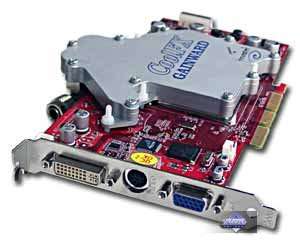 |
| AGP x8/x4/x2 interface, 256 MB DDR SDRAM in 16 chips on both PCB
sides. |
|
| Gainward Powepack FX Ultra/1600 GS CoolFX | |
| Hynix 2.2ns memory chips; it corresponds to 454 (908) MHz, but the memory work at 425 (850) MHz, the GPU runs at 450 MHz. 256bit memory interface. The proprietary utility lifts the clock speeds up to 500/900 MHz (according to the Golden Sample law). |  |
| Comparison with the reference design, front view | |
| Gainward Powepack FX Ultra/1600 GS CoolFX | Reference card NVIDIA GeForce FX 5900 Ultra 256MB |
 |
 |
 |
|
| Comparison with the reference design, back view | |
| Gainward Powepack FX Ultra/1600 GS CoolFX | Reference card NVIDIA GeForce FX 5900 Ultra 256MB |
 |
 |
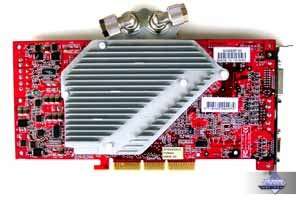 |
|
| Gainward Powepack FX Ultra/1600 GS CoolFX | 1600x1200x85Hz, 1280x1024x120Hz, 1024x768x160Hz |
Conventional signs: ANISO 8xP - Anisotropic 8x Performance (earlier it was called Balanced), ANISO 8xQ - Anisotropic 8x Quality, ANISO 16xQ - Anisotropic 16x Quality.
Test applications:
If you want to get the demo benchmarks that we use let me know by e-mail.
In the review of the RADEON 9800 PRO UE I drew your attention to how the trilinear filtering was simplified in some tests. First of all, it was in the UT2003. Today we will carry out the tests with the new drivers from ATI and NVIDIA.
The card reached 530/1000 MHz with the water cooling only! That is why the card was also tested at these clock speeds (in comparison with the overclocked RADEON 9800 PRO).
In the usual modes the card worked at the default frequency of 450/850 MHz.


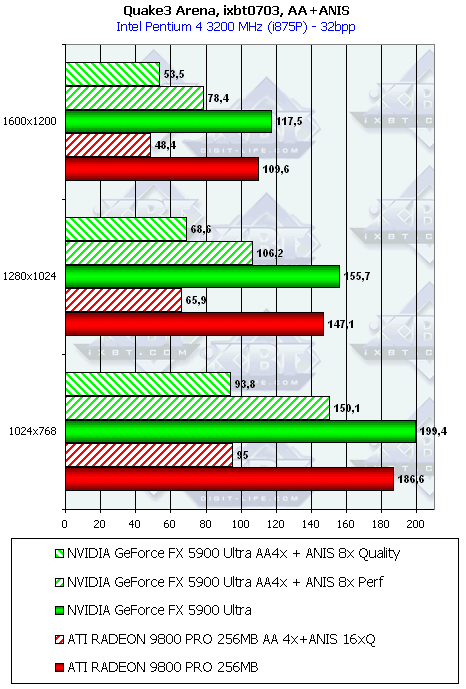

The new driver helped the 5900 Ultra strengthen its leading position. No complaints about the quality (though it can be skilfully hidden).
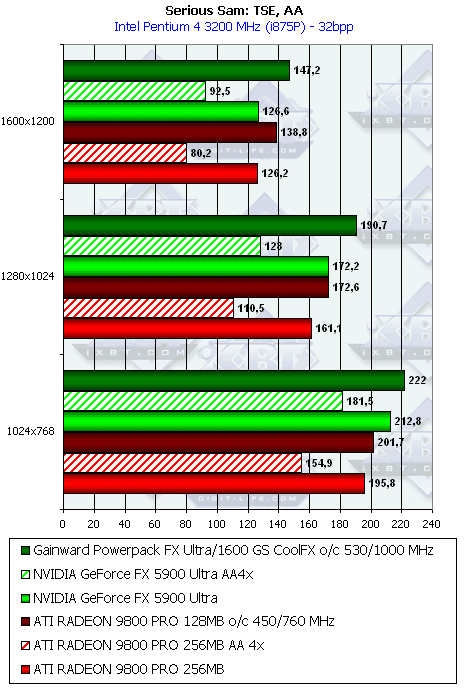
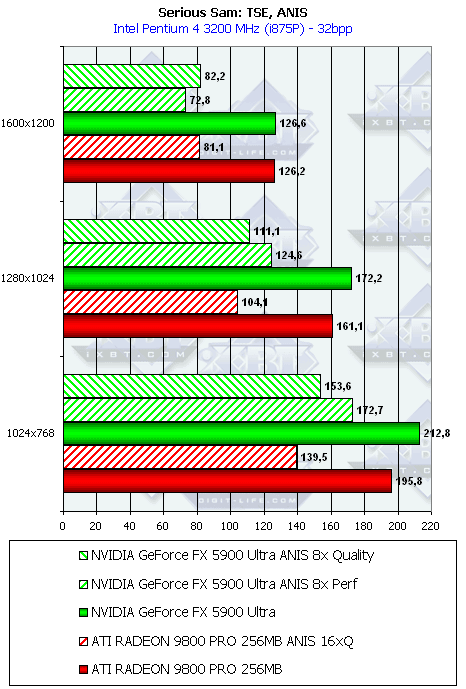
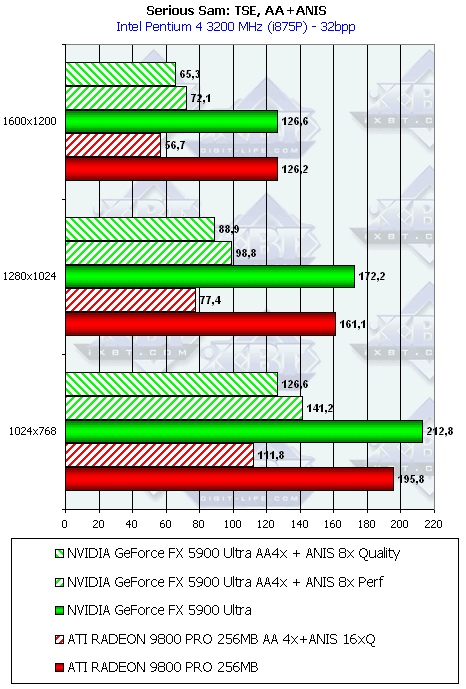

Just the same.
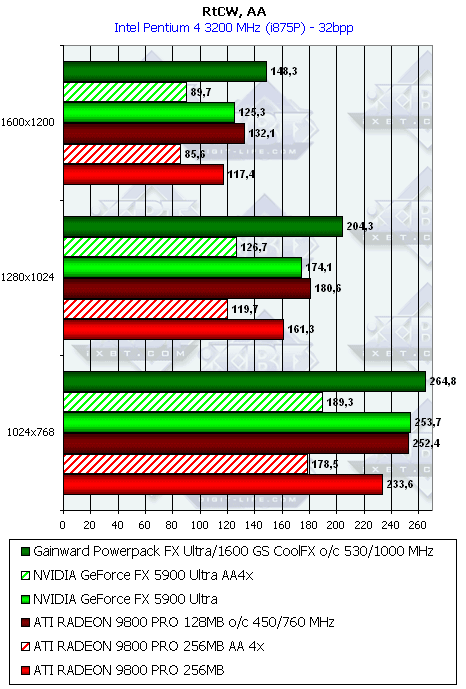

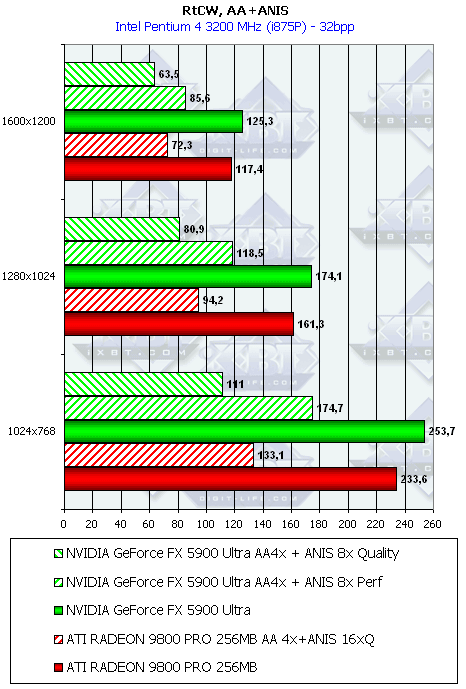

The figures are good, the 5900Ultra is ahead, but here is what we noticed:
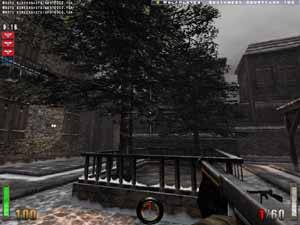
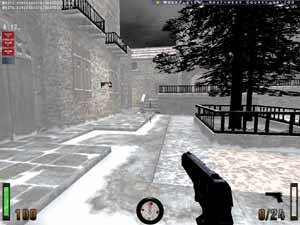
A lot of objects are light-struck though the leaves and sky have the color appropriate for this level.




The 5900Ultra wins in this test thanks to the optimizations. NVIDIA's latest response is that optimizations are possible everywhere be it a game or a benchmark if a given application is popular. They affirm that if quality is not affected, there is nothing to worry about. Well, the quality does not get worse because of the optimizations in this benchmark, that is why we just establish a fact that the 5900 Ultra takes the lead here.




The speeds of the competitors are approximately equal. But what about quality?
As you know UT2003 allows turning on/off the trilinear filtering and changing
the anisotropy degree (in UT2003.ini). Let's enable just the trilinear
filtering in the High Quality mode for both cards (ATI/NVIDIA). MIP levels
are colored with the variable "FirstColoredMIP 1".
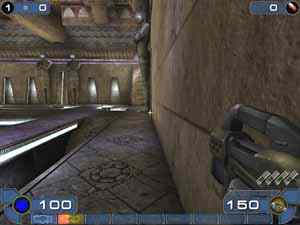



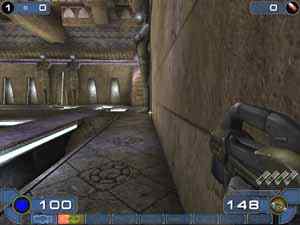



Although the drivers have the Quality preset the trilinear filtering is crippled. The version 51.75 didn't help. But I must say that I haven't notice the difference between the simple and full methods in the game, the border between the MIP levels doesn't catch my eye.
Now I'm forcing 16x and 8x anisotropic degrees at the Quality preset
in the drivers (the game itself has anisotropy disabled).
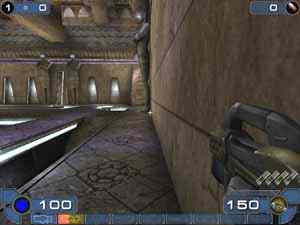



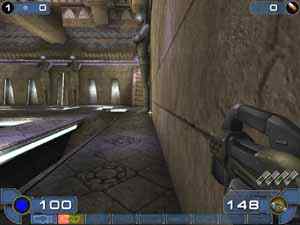

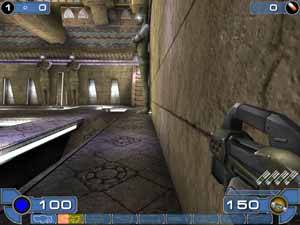

Surprise again! Well, we know from the previous test that NVIDIA lightens the trilinear filtering, but ATI also demonstrates it and last time they explained it with an error in the drivers. Why isn't it corrected now? But if NVIDIA can do that, why wouldn't ATI do the same. Poor users...
Now let's enable anisotropy in the game by correcting ut2003.ini and
disable it in the drivers.
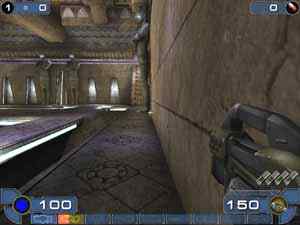
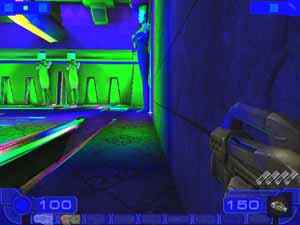
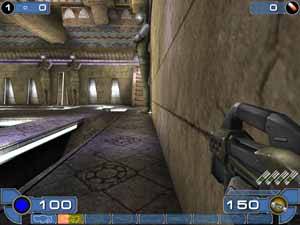

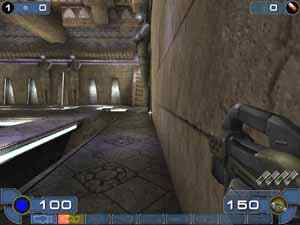
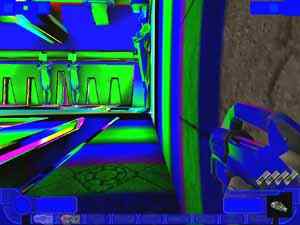


Finally the RADEON 9800 shows the normal trilinear filtering! ATI says it's because of the drivers' control panel when in the Quality mode the trilinear filtering is executed only for the texture stage 0, all the rest go with the bilinear filtering. It works for all games which "know" the independent anisotropy. But such an unpleasant picture appears because of the peculiarities of multitexturing in the UT2003. We were promised to have this flaw corrected, but it still exists.
As to the FX 5900, it doesn't have the normal trilinear filtering. It looks even worse than in the 45.23.
Well, everyone including the game developers are to be blamed.
The discussion will be developed in the next test as it's based on the same engine.
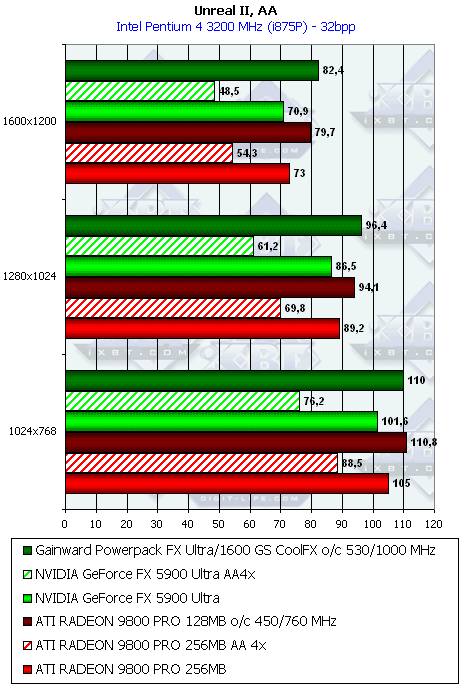
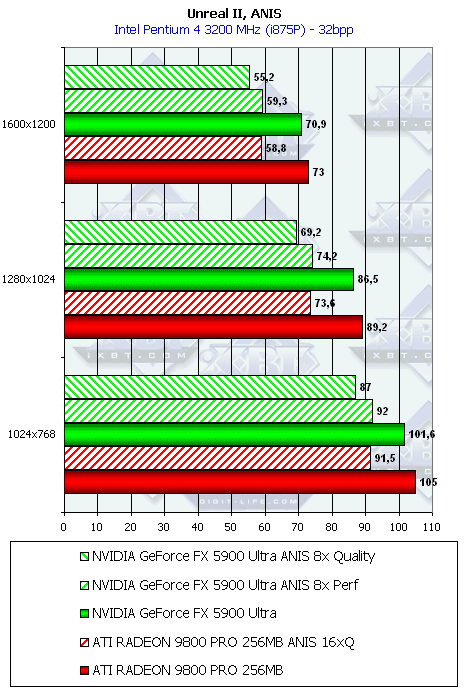
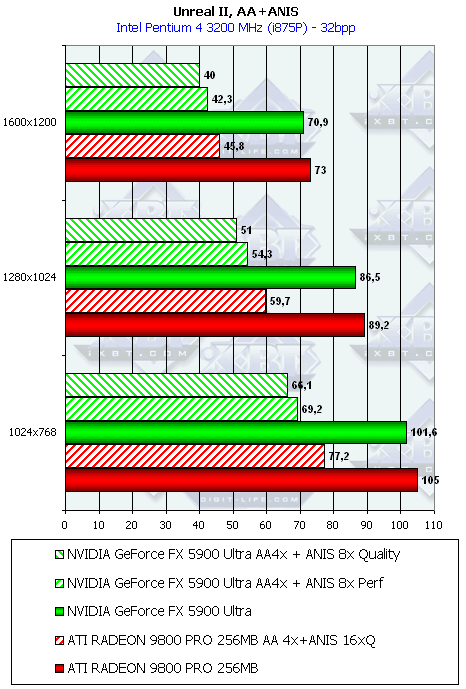

The FX 5900 Ultra still works slower though the gap is not that big as before. I wonder if optimizations are used here as well... the speed has grown by 51.75.
Unfortunately, MIP levels in the Unreal II are all colored into black
starting from the second level. However, it perfectly shows the border
between the MIP levels. Let's force anisotropy in the Quality mode where
the normal trilinear filtering must work (ANISO Forced) and also enable
it in Unreal2.ini (ANISO by Application) switching the forcing off:










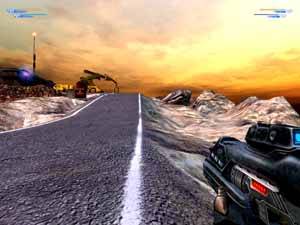

The trilinear filtering works though I think it looks lighter in case of the FX 5900. NVIDIA shows no difference between the anisotropy forcing and its enabling in the game while ATI has a little one.
With the v51.75 the FX 5900 loses fog in some scenes, which didn't take place in case of v45.23.
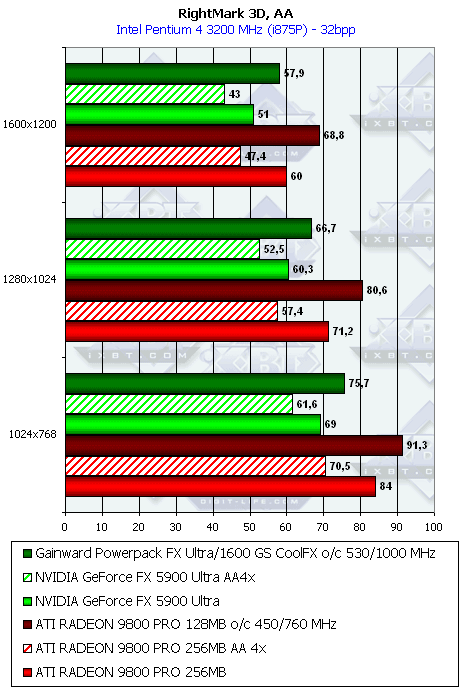



The RADEON 9800 grasps the victory thanks to the higher shader speed.
Well, judging by the overclocking scores the water cooling is really effective. The system was equipped with NO additional fans. The overclocking helps a lot to the GeForce FX 5900 Ultra. But is it worth such an unreasonably high price? Not sure. But nobody talk Matrox out of selling its Parhelia at high prices. I think there'll be few Gainward Powepack FX Ultra/1600 GS CoolFX cards released. Primarily for enthusiasts.
The driver version 51.75 was examined today only in the traditional tests (let's call them old), where shader technologies are applied only in two tests. There're some problems with quality, but it's not the final version yet. I hope NVIDIA will solve the problem. As to the optimizations, this issue is still discussable. Can NVIDIA fool those users who paid a lot for a top product by doing nothing to lift the speed? Surely, they can't. I think that by lowering quality levels in unimportant scenes the experts do increase the speed. There're no other wayouts. Another problem is the price.. it certainly should be cut down.
In general, the Gainward Powepack FX Ultra/1600 GS CoolFX can offer you:
In our 3Digest you can find full comparison
characteristics for video cards of this and other classes.
Write a comment below. No registration needed!
|
Article navigation: |
| blog comments powered by Disqus |
| Most Popular Reviews | More RSS |
 |
Comparing old, cheap solutions from AMD with new, budget offerings from Intel.
February 1, 2013 · Processor Roundups |
 |
Inno3D GeForce GTX 670 iChill, Inno3D GeForce GTX 660 Ti Graphics Cards A couple of mid-range adapters with original cooling systems.
January 30, 2013 · Video cards: NVIDIA GPUs |
 |
Creative Sound Blaster X-Fi Surround 5.1 An external X-Fi solution in tests.
September 9, 2008 · Sound Cards |
 |
The first worthwhile Piledriver CPU.
September 11, 2012 · Processors: AMD |
 |
Consumed Power, Energy Consumption: Ivy Bridge vs. Sandy Bridge Trying out the new method.
September 18, 2012 · Processors: Intel |
| Latest Reviews | More RSS |
 |
Retested all graphics cards with the new drivers.
Oct 18, 2013 · 3Digests
|
 |
Added new benchmarks: BioShock Infinite and Metro: Last Light.
Sep 06, 2013 · 3Digests
|
 |
Added the test results of NVIDIA GeForce GTX 760 and AMD Radeon HD 7730.
Aug 05, 2013 · 3Digests
|
 |
Gainward GeForce GTX 650 Ti BOOST 2GB Golden Sample Graphics Card An excellent hybrid of GeForce GTX 650 Ti and GeForce GTX 660.
Jun 24, 2013 · Video cards: NVIDIA GPUs
|
 |
Added the test results of NVIDIA GeForce GTX 770/780.
Jun 03, 2013 · 3Digests
|
| Latest News | More RSS |
Platform · Video · Multimedia · Mobile · Other || About us & Privacy policy · Twitter · Facebook
Copyright © Byrds Research & Publishing, Ltd., 1997–2011. All rights reserved.